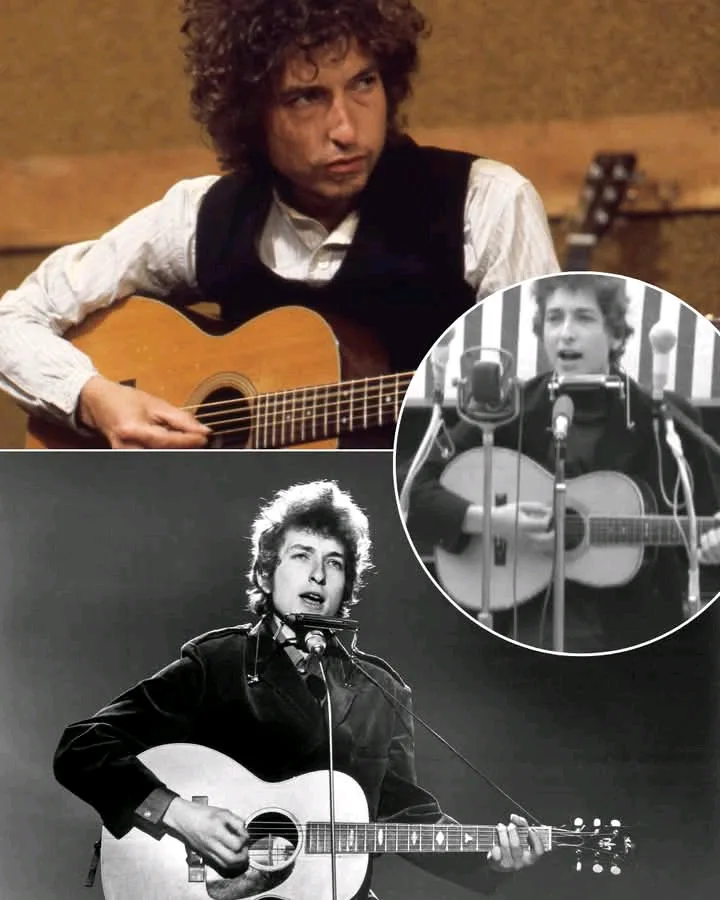Bob Dylan SHOCKS Newport 1965 with “Like A Rolling Stone” – one electric guitar and the entire folk world loses its mind! Loyal fans booed, purists panicked, but history witnessed the moment a folk poet turned into a rock prophet. They called it betrayal – Dylan just plugged in and triggered a sonic revolution that made the whole world turn up the volume…..

In the summer of 1965, amidst the rolling hills and vibrant musical community of Newport, Rhode Island, a moment unfolded that would forever alter the landscape of American music. Bob Dylan, the quintessential folk troubadour known for his poetic lyrics and acoustic guitar, had been steadily garnering attention for his lyrical ingenuity and his role as a voice of social change. Yet, on July 25, 1965, Dylan took a daring leap that would ignite controversy and inspire generations: he plugged in an electric guitar during his performance at the Newport Folk Festival, electrifying his sound—and the entire folk world—indelibly.
The audience at Newport, steeped in traditional folk and acoustic music, was largely unprepared for what was about to happen. For years, Dylan had been celebrated for his intricate fingerpicking, storytelling, and his commitment to acoustic folk. His concerts, albums, and appearances embodied the spirit of authenticity, sincerity, and a close connection to roots music. But by 1965, Dylan was increasingly drawn to the burgeoning electric sound that was defining rock and roll, influenced by artists like The Byrds, The Beatles, and The Rolling Stones. The decision to go electric was both a bold artistic statement and a potential betrayal of folk purism.
When Dylan stepped onto the Newport stage that day, he was accompanied by a band—most notably, guitarist Mike Bloomfield and bassist Harvey Brooks—that would help craft a new, electrified sound. As he launched into “Maggie’s Farm” and eventually “Like A Rolling Stone,” the crowd’s reaction was immediate and intense. Many in the audience, still clinging to the purity of traditional folk, booed and jeered, perceiving the electrification as a sell-out or a betrayal of the music’s roots. Some folk purists felt Dylan was abandoning the message and authenticity that had made him a voice for social justice and change.
The reaction was polarizing—some fans felt betrayed, believing that Dylan’s new electric sound was a departure from the honest storytelling and acoustic intimacy they cherished. Critics and purists argued that he was losing his voice as a social prophet, becoming just another rock star chasing commercial success. However, others recognized the significance of the moment: Dylan was not just experimenting with sound, but revolutionizing the very essence of folk music, blending it seamlessly with rock, and expanding the possibilities of songwriting and performance.
What made the Newport incident so groundbreaking was not just the act of plugging in, but what it symbolized. Dylan was challenging the boundaries of genre, authenticity, and cultural identity. He was refusing to be confined by traditional expectations of folk music, instead embracing the electric guitar as a tool for new expression. This moment marked a turning point in his career and in the history of popular music at large.
In the aftermath, Dylan faced both backlash and admiration. Some critics saw his electric debut as a betrayal, but others recognized it as a prophetic move—an indication that folk and rock could coexist and evolve. Dylan himself explained that he was simply following his muse, seeking new ways to communicate and connect. His subsequent albums, most notably “Highway 61 Revisited” and “Blonde on Blonde,” cemented his reputation as a rock innovator and a poet who refused to be confined by labels.
The “shock” of Newport 1965 was not merely about the sound; it was about the courage to defy expectations and redefine an entire musical landscape. Dylan’s electric performance signaled a sonic revolution—one that made the whole world turn up the volume—ushering in an era where boundaries between genres blurred and artists could reinvent themselves without losing their core message. The folk world, which had once seen Dylan as its emblem, was forced to confront the idea that evolution and experimentation were essential for growth.
Over time, Dylan’s electric phase has been recognized as a pivotal moment in music history. It challenged notions of authenticity, inspired countless musicians to push boundaries, and proved that true artistry often involves risk and rebellion. The moment at Newport remains a symbol of artistic courage—the day when Dylan, the folk poet turned rock prophet, refused to stay silent, choosing instead to electrify his voice and spark a sonic revolution that would resonate for decades to come.



